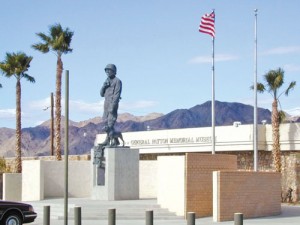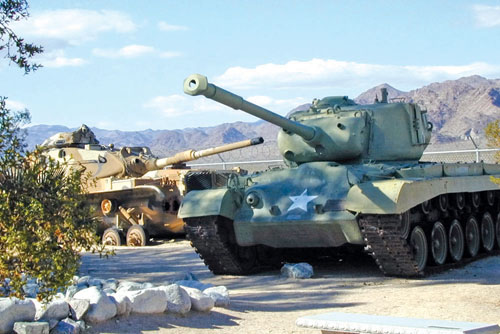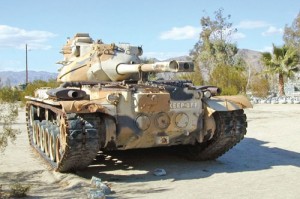By Greg Brown
“I wonder if there’ll be time to land at the Patton Museum,” I mused.
“I hope so,” said my wife Jean. “You deserve it for flying me to Palm Springs. Besides, I’m getting sick of hearing about it.”
I looked forward to delivering Jean to her annual tennis camp. Not only is Palm Springs an interesting aerial journey from Phoenix, but the route also presented an unfulfilled “Flying Carpet” adventure.
Years before, I’d noted remote, unattended Chiriaco Summit Airport along Interstate 10 between Blythe, Calif., and Palm Springs. Surely I’m not the only pilot who looks down at such out-of-the-way places and wonders what’s there. Then someone told me that southeastern California had hosted the Army’s Desert Training Center during World War II. And that within steps of Chiriaco Summit Airport is the General Patton Memorial Museum.
From then on, I yearned to visit when flying over. Could those be Army tanks west of the field? Obligations always beckoned, however, and in any case, Jean didn’t share my enthusiasm for touring tanks in the desert. Each time I suggested landing she’d say, “The airport’s unattended, right? What if the engine won’t start when we’re ready to leave?” And Chiriaco Summit would fade from sight behind us.

General Patton’s larger-than-life monument greets visitors to his namesake museum at Chiriaco Summit.
What had started as a whim grew stronger with each overflight. Eventually, a dedicated trip seemed justified to get there. My son, Austin, volunteered to join me, but he was always busy when I wanted to go. Then he left for college. Others merely chuckled when I proposed three hours aloft to examine aging military vehicles. Clearly, I needed to accomplish this mission on my own.
Twice I planned solo flights to the museum, only to be thwarted by bad weather. There were also climatic considerations–the Mohave Desert is no summertime destination. As each winter season passed, I postponed my visit for another year.
Jean’s tennis camp now offered new opportunity to visit. With two round trips over Chiriaco Summit, surely there’d be time to land on one of the empty legs. The weather wasn’t great when we departed Phoenix on Saturday morning, however. A rare cold front scoured southern California with powerful winds. Turbulence and blowing dust were forecast along the route, as well as possible rain later that afternoon.
“Are you landing here after dropping me off?” asked Jean when we crossed Chiriaco Summit. (I noted emphasis on the word “after.”)
“Possibly, though winds are so strong today that I might wait until the return trip on Wednesday,” I said.
Sure enough, our destination, Bermuda Dunes Airport, featured winds gusting to 25 knots. The Bermuda Dunes pattern is challenging in itself, as Runway 28 requires descent over an elevated highway interchange. Add downdrafts cascading from nearby 10,000-foot mountains, plus wind shear from tall trees lining the runway, and landing was a handful.
Escorting Jean to a cab, I watched the wind buffet those trees. Should I postpone the Patton Museum until the return trip? But with Wednesday’s schedule uncertain and this afternoon free ahead of me, I reconsidered. Why not have a look?
Urged eastward by a mighty tailwind after takeoff, I hugged the freeway into Chiriaco’s desert pass. Although whizzing past trucks like a rocket, I spotted no telltale haze hugging the ground; that ruled out the hazards of blowing sand. And the airport’s windsock suggested 20-knot winds, 30 degrees off the runway. That would be challenging, but not impossible. Also encouraging were two airplanes parked on the ramp.
Turning final, I noted a hefty crab angle, but upon entering a crosswind slip saw that with proper technique, touchdown would be manageable. Only then did I commit to landing. Deflecting controls into the wind, I taxied to the small paved ramp, parked the nose into the gale, and chocked the wheels.
Wintertime sun helped temper the cold wind as I walked from the airport. I pitied the freeway travelers filling their tanks at the adjacent gas station and their bellies at the nearby Mexican café. By car, it’s a long trek to anywhere from here.
It seemed for a moment that I’d missed the museum in this handful of buildings, but beyond the tiny post office, I suddenly encountered General George S. Patton, standing oversize in bronze before a bunker-like building. Inside, I paid my fee and wandered the small exhibit area–slowly so as to savor my long-awaited visit. A brief film described Patton’s founding of the Desert Training Center and how its graduates defeated Germany and Italy in the North African campaign. A huge topographical model marked desert training locations, along with the nearby aqueduct and canal supplying Los Angeles with Colorado River water.
Outside, I investigated the museum’s broad collection of WWII armored vehicles and visited a small outdoor chapel built for the men who trained here. Then I wrote Austin a Patton Museum postcard and walked to the airport. Despite my leisurely examination, the visit had lasted hardly more than half an hour. But at the airport waited another attraction–a California Highway Patrol Cessna 206. Generously, Officer-Pilot Gary Baldwin showed off his law enforcement equipment.
“What’s that?” I asked, pointing to an unfamiliar panel display.

Although inferior to many of its opponents in armor and armament, the Sherman was the most produced tank of World War II, and as a result ranked among our most important victory weapons.
“A LoJack receiver for tracking stolen cars; we’ve recovered about 150 of them in the past year and a half,” he said. Officer Baldwin also told of tailing criminals along San Diego’s busy freeways, and in fulfillment of every pilot’s fantasy, landing routinely on the interstate.
“Cool!” I said. “Do patrol cars clear the area of traffic before you touch down?”
“Not always,” was the answer. “When something serious happens and there are no surface units nearby, I do a ‘high recon’ followed by a ‘low recon,’ and then go ahead and land. Given the distances here, we’re often first at the scene for accidents, so all CHP officer-pilots are qualified as EMTs.”
While I preflighted the Flying Carpet, Officer Baldwin taxied out and took off.
“Have a good trip,” radioed the officer when I made my own takeoff announcement. “Let me know if you’d like to ride along on a media familiarization flight sometime.”
“Would I! Thanks!”
In calmer weather, I returned on Wednesday to pick up Jean.
“Did you visit the Patton Museum?” she asked.
“Indeed I did, on my way home Saturday.”
“I’m glad,” she said. (The gladness seemed mostly at deleting the topic from future California flights.) After describing the museum, I told her of the CHP officer I’d met, how he tracks bad guys from the air and lands on freeways, and about his ride-along offer.
“Now that sounds exciting!” said Jean. “You’re going, aren’t you?”
With flying, you never know what adventure you’ll find on a given flight. Although not necessarily what you expected, there’s always a tale to tell when you get home.
Author of numerous books and articles, Greg Brown is a columnist for AOPA Flight Training magazine. Read more of his tales in “Flying Carpet: The Soul of an Airplane,” available through your favorite bookstore, pilot shop, or online catalog, and visit [http://www.gregbrownflyingcarpet.com].














